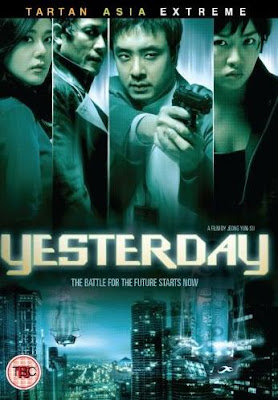May 31, 2008
Same site, new look
There's finally a banner, which goes partway to explaining one of the reasons this is called Black Hole in the first place - an image of the well from Ring (1998), the movie that turned me onto J-horror in the first place. Japan and South Korea keep rewarding me with fresh and masterly offbeat cinema, just when I thought I'd seen it all.
The Black Hole is also a favourite movie of mine from the seventies, a decade I can't stop delving into for movies to recommend. The scientific phenomenon of the inexorable gravity of a black hole also represents my appetite for film.
It may look different, but I'll still be reviewing the same mix of movies, I just wanted to try and make it look a little smarter.
TRANSATLANTIC TUNNEL (1935) - not on DVD

THE TUNNEL(UK, 1935)
While huge feats of engineering could one day be possible, the question is why bother? Only a British film would flatter itself that a tunnel between Britain and America is a good idea, let alone a way to bring World peace! There are scenes of both the British Prime Minister (George Arliss) and the US President (Walter Huston) selling it as a good idea, instead of anyone actually explaining what the point is. If anything, a tunnel link between USA and continental Europe would surely be a better idea.
This was based on a German novel, but the script was written by Kurt Siodmak, who also wrote the original story of The Wolfman (1941), which is currently being remade with Benicio Del Toro for 2009.
There weren't many serious sci-fi films made in the UK before the 1950's. Things to Come (1936) was the most famous, but was more of a hypothetical history lesson, than a drama.

The Tunnel is far more engaging and packed with melodrama. Above ground it's centred on a four-sided love triangle, underground there's a battle against the odds - trying to keep up the progress of the drilling, despite the financiers wheeler-dealing the project.
Like any engineering work on this scale, there's likely to be a loss of lives - but at least the designer and manager of the project (Richard Dix) gets his hands dirty, and when the going gets rough, he doesn't talk to the workers through a layer of middle-management. But will his marriage survive?
The acting may be stilted, even for the time, but the story is unpredictable and occasionally touching. I also enjoyed the 1930's vision of the future, especially the spectacular and colossal radium drill. The subway cars in the tunnel look retro cool too.
The cars and planes (a vertical takeoff bi-plane!) are not-so-futuristic looking. The 'new' inventions include the 'enunciator' (a loudspeaker), and the 'televisor' - a telephone with a video screen.
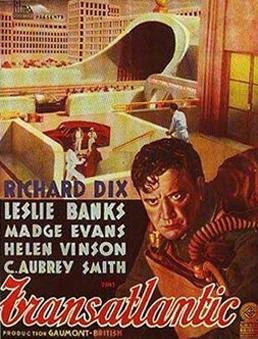
Fans of classic horror may recognise the star Richard Dix, as the stalwart chief engineer. He later starred in the classic Val Lewton RKO thriller The Ghost Ship (1943). His co-star is Leslie Banks, who played the sadistic Count Zaroff in The Most Dangerous Game (1932). Though the one-sided camera coverage, constantly avoiding the scarred side of his face, is very obvious. Here he plays a more jovial best-friend character, attempting to escape typecasting as two-faced villains. He later starred in the excellent adaption of Went the Day Well? (1942).
The Tunnel was last available on VHS in the USA (see artwork at top), but isn't currently on DVD anywhere. It should run at just over 90 minutes.
May 28, 2008
YESTERDAY (2002) - future cops
Korea seems very keen on action/sci-fi in the Blade Runner vein. Though this movie isn’t as ambitious or as futuristic as Natural City (2003), the airborne overhead advertising pods and incessant rain are pointers to their main visual inspiration.
Yesterday isn’t set too far in the future (2020), but the police are using robot insects to look around a hostage situation. When the storming of the siege goes sour, a detective called Seok can’t get over the tragic results, and he continues to search for a priest involved in the case.
This is a new re-unified Korea, but where the border used to be, a top secret experiment from the past now leads to a series of high-level assassinations. When the Police Chief is kidnapped, another hunt begins and Seok teams up with the Chief’s daughter to investigate, not realising how close to home the mission will get.
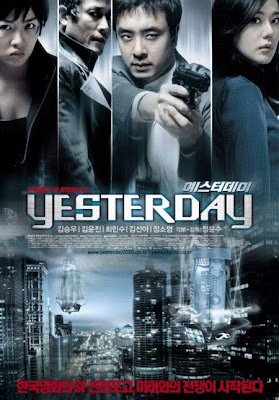
While the plot is twisty enough, and the setting has some futuristic embellishment, the story seems to take second place to a long series of furious high calibre gunfights. Beside the two leads, the secondary characters are reduced to little more than a collection of brightly coloured hair-styles, so we can tell who the good guys are. Seon-a Kim as May (pictured top left in the poster, top right on the DVD), is the only one who stands out from the back-up team, a kickass female special op who gets a lions share of the gunplay.
The Police Chief’s daughter is also a serial killer profiler, who is also handy with a gun. Played by Yun-jin Kim, she demonstrates a convincing command of English in one scene, and was soon afterwards snapped up as a regular character in Lost, where she plays a far meeker role. Kim had previously played a gun-toting action woman in Shiri (1999).
Yesterday is slickly made and fast-moving, though I was hoping for a few more inventive alternatives to armed response in the future of law enforcement. It’s now available in the UK on DVD from Tartan, and is also out in the US.
- - - - - - -
May 27, 2008
FRANKENSTEIN CONQUERS THE WORLD (1965) - sort of
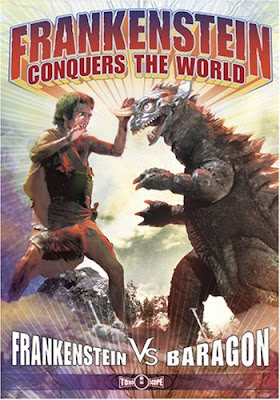
Here's a plot you don’t see very often. In WW2, the Nazis seize what's left of Frankenstein's monster (a living heart), and ship him to their allies in Japan. As the scientists are on the verge of using the heart to create indestructible soldiers (to presumably win the war), the lab is nuked, as it was located in Hiroshima. Unlucky!
15 years later, a strange boy appears in the forest. The heart has survived the blast and completely regenerated the Frankenstein monster – which explains the secret of it surviving so many Universal horror films in the forties. Somehow, the script is allowed to confuse the name of the Doctor with the monster, and it’s refered to as Frankenstein.
There's then some blunt deductive work and trifling medical moral dilemmas as one scientist regards the boy as being as disposable as a laboratory guinea pig. He uses the logic that if the arm is cut off and then regenerates, that'll prove it's Frankenstein!
Then, following the time-honoured Ultraman rulebook, (if it's a monster, it'll automatically grow 5 storeys high), Frankie goes large. This special effect is realised by the actor pacing around amongst model sets, without the use of slow-motion, which makes it look even more like an actor pacing around model sets.
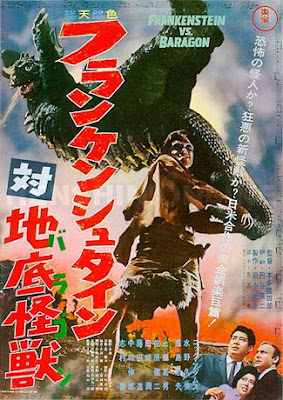
So Toho, you've got a new monster, what are you going to do with him? Well, he's going to have to meet another monster - talk about yin and yang. Suddenly, a non-extinct dinosaur appears who's ducked the ice age by living underground. Baragon is good at burrowing, he has a big horn, big ears, a heat ray, and can leap toy tanks in a single bound. Is it possible it's a kind of dinosaur, professor? "Highly improbable." You said it, prof.
As Frankie's story gets bogged down with a long manhunt, we eventually get some good monster fights, a spectacular miniature forest fire, and a double climax. After the main event is over, someone says, "Look a giant octopus", and round two begins.
The title alone meant I wanted to see this thirty years before I got the chance. The photos in Famous Monsters of Filmland made the wait feel even longer. It’s not all monsters either, because the sparks are flying between American import Nick Adams (also the star of Die Monster Die) and the alluring Kumi Mizuno (of Godzilla: Final Wars 2004, Matango - Fungus of Terror 1963, and the essential Godzilla flick, Invasion of the Astro-Monsters 1965).
While America is still waiting for a complete set of Godzilla DVDs, it's good to see the other Toho monsters also being released.
Disc 1 in the superb Media Blasters 2-disc set of Frankenstein Conquers the World has the Japanese Version with two possible endings (choose the ‘international’ option for the rare alternate octopus ending). Disc 2 has the English dubbed US version and more extras. All three versions have been presented in 2.35 widescreen for the first time in an English video release. Thank you Media Blasters, you're forgiven for Legend of Dinosaurs and Monster Birds…
If you want to see more pix, there's some screengrabs from at DVD Beaver, and a complete list of extras at SciFi Japan...
May 23, 2008
ROUGE (1987) - a very different Chinese ghost story
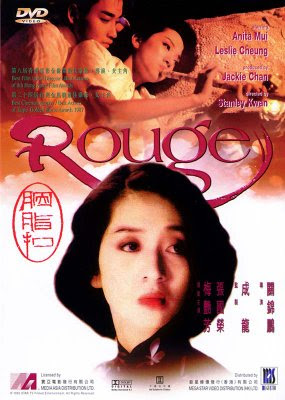 ROUGE
ROUGE(1987, Hong Kong, Yin ji kau)
Highly recommended and unique drama from Hong Kong
Rouge is an impeccably made film, starring two superstars of Hong Kong cinema. While it’s not a typical Black Hole horror film, it’s worth recommending to lovers of unusual Chinese cinema. It’s easier to say what genres it doesn’t belong to – not the usual wire-work action-comedy ghost story that Hong Kong is famous for. Nor a scary Japanese ghost tale either. It’s a straightforward drama, told as if ghosts could exist among us today…
I first saw Rouge around 1990, when there was a sudden upsurge of interest in Hong Kong cinema in England. Just as Ring and Battle Royale drew the world’s attention to Japan, the films of Jackie Chan and Tsui Hark started to appear in art cinemas and even on TV – causing a flurry of interest in Hong Kong fantasy and action films. At the time, I was lucky enough to see Tsui Hark’s Zu Warriors of the Magic Mountain and The Heroic Trio on a big screen, and Channel 4 ran an important season of Chinese Ghost stories over a couple of Christmases. Among them was Rouge, a gentle ghost story – no blood, no screaming skulls, but an unforgettable quality film from a country that I’d formerly only expected badly dubbed Kung Fu films from.
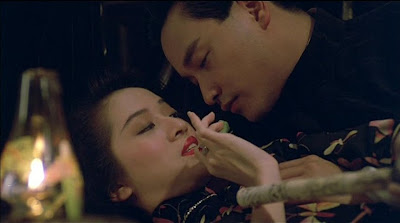
The story starts as a great romance begins in 1930’s Hong Kong. A rich storeowner’s son falls for a prostitute and he wants to spend his life with her. He seems as addicted to seeing her in her ornate ‘boarding house’ as he is to smoking opium. His family however have other ideas...
Coincidentally perhaps, Rouge was also the name of the first dramatic Cantonese feature film ever filmed, back in 1924. Director Stanley Kwan is keen to contrast the two time-frames, the guilty pleasures of 1934 with todays sexual freedoms. He carefully recreates a sumptuous atmosphere for old Hong Kong, betraying a sense of loss for the style and etiquette of the period.
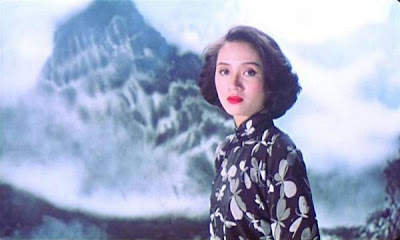
Then suddenly, we’re in modern day Hong Kong (well, 1987) and Fleur is now a ghost, waiting in limbo, trying to find her lost love. She meets a pair of journalists when she tries to place an ad in the paper. They learn about her life, and she learns about how Hong Kong has changed over fifty years. Then we learn more about her tragic love story, and the bargain she made with Chan.
Anita Mui is ethereal as Fleur as a ghost, as well as convincing us she used to be the a sought-after concubine, despite the actress’ unconventional beauty. The film has since become all the more poignant by the tragic deaths of both actors who played the star-crossed lovers. Anita Mui had mastered every type of role – as a stunt-heavy stooge in Jackie Chan movies, performing wire-work with grace in The Heroic Trio (alongside Maggie Cheung and Michelle Yeoh), and even broad physical comedy as the two sisters in Saviour of the Soul (opposite Andrew Lau). She was also a hugely popular singer, like Leslie Cheung.

Leslie, who plays her lover Chan, also excelled in the wide range of typical Hong Kong roles, starring in everything from high-flying period fantasy in A Chinese Ghost Story (1987) and it’s sequel, through gangster dramas like A Better Tomorrow (with Chow Yun Fat), to arthouse cinema like Farewell My Concubine. He also dared to make controversial low-budget independent movies, like Happy Together (for Wong Kar Wai). Almost as beautiful as Anita Mui, they make a perfectly matched handsome couple on screen.
Rouge is clever and involving, tragic and dramatic – a very unusual Chinese ghost story.
Though it’s not on DVD in the US or UK, there are several editions out around Asia. I got the HK Contemporary Collection remastered edition from Fortune Star in South Korea, which has beautiful picture quality and DTS sound, but the aspect ratio is inexplicably cropped at the top, often obscuring the tops of actors heads! I want to see faces, not feet! It doesn’t spoil the action too much, but it’s hardly considerate framing. There are good English subtitles, except for a couple of instances of signs and headlines not being translated. There’s also a small book full of colour photographs from the film, some looking like blurry frame blow-ups.
You can see more images from the film, here on Hong Kong Cinemagic.
May 22, 2008
THE EYE 3 (2005) - the third Eye is the weakest

THE EYE INFINITY
THE EYE 3
(2005, Hong Kong/Thailand, Gin Gwai 10)
I love The Eye (2002) and was surprised at how good The Eye 2 (2004) was. Now I'm surprised at how bad The Eye 3 is - an unfunny comedy-horror from the Pang Brothers (who directed the first two films) is sneaking around under several titles, usually as The Eye 10 and The Eye Infinity, and is finally being released on DVD in the USA, under the more accurate title The Eye 3.
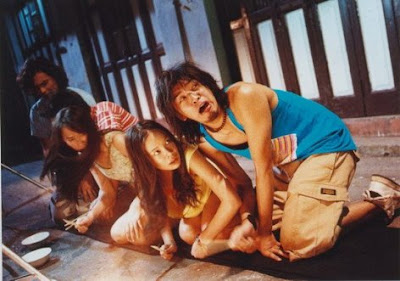
So beware – the cover art may look like a horror film, but it’s really trying hard to get laughs, with the directors aiming to spoofing their own films. They only get it half right – some of the scares work, but the humour doesn’t. For instance, the opening scene of a Buddhist exorcism. Inside a circle of monks, a young girl begins to levitate and act like a Linda Blair possessed. Her tongue begins to loll out of her mouth… But they take it a step too far and have the tongue slap the monks around, Three Stooges style! The scene was working fine until the gags crept in. Guess they haven’t seen Repossessed.
Another problem with the film is its completely disjointed nature, with a far less focussed plot than the first two films. Four friends on holiday in Thailand are telling ghost stories, and their Thai friend convinces them there are actually 10 ways to see real ghosts. The first two ways having been explored in the first two films - “yeah, we heard about them”.
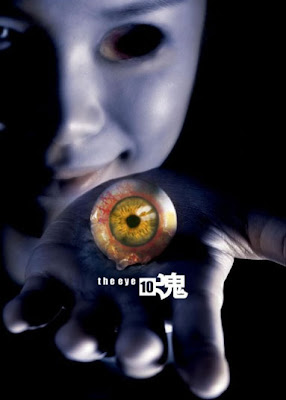
As they work their way through the next 8 ways, there’s an uneven cross between Thai horror and broad Chinese comedy. The film works in places, like one scene when they are sitting in a deserted street at night trying to lure ghosts out with food.
But rather than a series of spoofs, this looks more like leftover, under-developed ideas. There’s also a constant assumption that seeing ghosts means danger. Surely, the ghosts are around all the time – they are only in trouble if the ghosts have a motive to do the characters harm.
By far, the worst scene is when a possessed human gets mistaken for a body-popper by two B-boys, who then try and engage in a challenge dance. No, no, no.

The cinematography is colourful, moody and predictably green for ghostly scenes. But unlike The Eye 2 where the editing was calm, the cutting style here is fast and random. The special effects start off well with some ghastly make-up effects, but then there’s an over-reliance on an easy electronic ripple effect over many of the ghosts – obscuring their features.
The whole mess certainly explains why there haven’t been any more Eye sequels since…
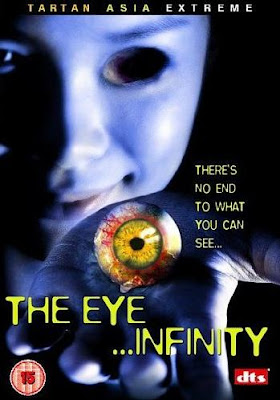
The Eye 3 is getting released in the US at the end of June, with that misleadingly scary cover… It’s already out in the UK and around Europe.
- - - - - - -
'Comic book' movie season in London in July
It starts in July and will be a rare chance to see these on the big screen. I’d recommend the following selection…
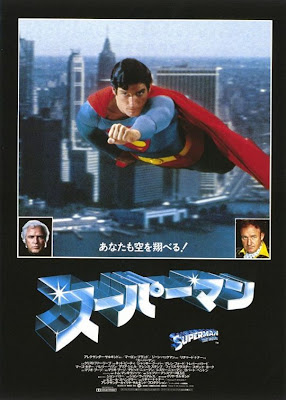 SUPERMAN – THE MOVIE (1978)
SUPERMAN – THE MOVIE (1978)
Christopher Reeve's first Super-film featured Marlon Brando as his Jor-El and Gene Hackman as Lex Luthor. The Director’s Cut of the seventies blockbuster will be shown, that includes a recently added eight minutes of footage.
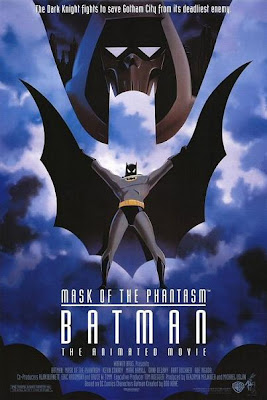 BATMAN – MASK OF THE PHANTASM (1992)
BATMAN – MASK OF THE PHANTASM (1992)
The first animated Bat-movie puts the Joel Schumacher films to shame, with a downbeat plot, adult drama, suitably dark production design and Shirley Walker’s moving soundtrack. The mysterious Phantasm embarks on a killing spree, forcing Bruce Wayne to face demons from his past.
 MODESTY BLAISE (1966)
MODESTY BLAISE (1966)
Very mad, very mod, very sixties mish-mash which certainly looks great, but I wish Joseph Losey had taken comics slightly more seriously. Full review and more pix here.
 FLASH GORDON (1980)
FLASH GORDON (1980)
Max Von Sydow as Emperor Ming, what are you waiting for? This colourful remake of the thirties cliffhanger serials sticks its tongue in its cheek and attempts to outcamp Barbarella. From the director of Get Carter! Take your own deadly bore-worms...
 AKIRA (1988)
AKIRA (1988)
The adult cyber-punk epic that kick-started anime to international fame. I can only hope that Leonardo Di Caprio's remake does it justice. This is the original, set in Neo-Tokyo, where the government have supressed all knowledge of a secret project that threatens to destroy the entire city. One boy and his bike tries to save both his best friend, and the city.
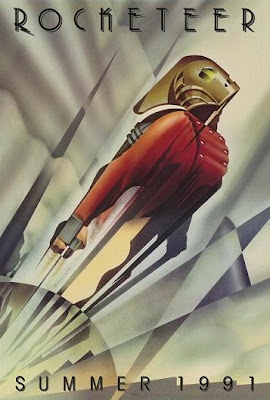 THE ROCKETEER (1991)
THE ROCKETEER (1991)
A completely under-rated, two-fisted, action fantasy. A good pick-me-up for anyone missing the oldschool Indiana Jones movies. Our hero dons a rocket-pack to thwart Nazi hi-jinks in 1930's Hollywood. Stars Bill Campbell, Jennifer Connelly and Timothy Dalton.
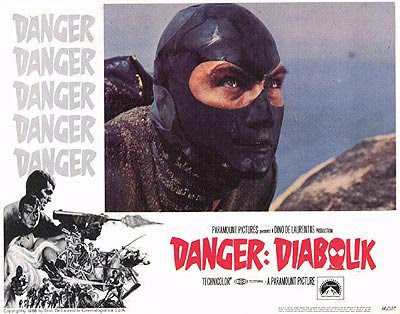 DANGER: DIABOLIK (1968)
DANGER: DIABOLIK (1968)
Mario Bava directs the late John Phillip Law in this delirious comic strip movie. It’s good to be bad (maniacal cackling…), Diabolik robs from the rich, and keeps it! Will the police ever catch him?
More from this season will be screened in August, concentrating on graphic novels, including GHOST WORLD, SIN CITY and A HISTORY OF VIOLENCE. For details, and to book tickets, see the BFI website.
Akira, Batman, Rocketeer, Superman, Flash Gordon posters from the IMP Awards.
- - - - - - -
May 19, 2008
I'M A CYBORG (2006) - a lighter shade of OLDBOY

After the huge international stir caused by his legendary 'Vengeance trilogy', Sympathy for Mr Vengeance, Oldboy, Lady Vengeance - director Chan-Wook Park has confounded expectations with this eccentric comedy set in a psychiatric hospital.
Working in a huge electronics factory, Young-goon (Su-jeong Lim) is happily talking to the overhead lights. Electrical things are her friends, because she thinks she is a cyborg. Voices talk back to her through a radio. They tell her to stick power leads into her veins to repower herself. She does. It looks like a suicide attempt, so off to hospital she goes.
She gets introduced to a circle of inmates, each with wildly different delusions, caused by pivotal events in their pasts. Il-sun (played by pop idol Rain) thinks he’s a giant rabbit who can steal anything. As Young-Goon’s mental and physical state deteriorates, can he use his skills to help her?

The narrative of the film gets completely lost for a while as the various other patients are introduced. There’s some black comedy as these characters bounce off each other, as long as you’ve memorised all their neuroses and backstories. But it's hard work when you realise that they have little bearing on the central relationship. The crux is whether Young-goon really is a cyborg or not, and we’re teased by the director that what we see is all in her mind - are there really power-up lights in her toes?
I was mindful that surreal movies about madness often indicate that we're in the mind of one of the patients - a movie premise used as far back as The Cabinet of Dr Caligari (1920).
But the story failed to grab me until an hour in, when some spectacular scenes reminded me of classic Oldboy, rather than the early dawdling comedy, like the prison scenes in Lady Vengeance. Cyborg starts off whimsically amusing, but the long wait for the plot may turn the fans off. Similarly confusing is the ending, a distinct difference from the tight narratives of the Vengeance films.

The production design delivers a colourful and stylish asylum, with vibrant green padded cells, modern art in the gardens and very 'now' wallpaper in the canteen. I thought it was supposed to be either a hugely expensive hospital, or another inmate’s delusional take on the usual drab décor of these institutions.
This is closer to a fantasy world, especially the Willy Wonka factory where she worked. So I shouldn’t have been too troubled about the simplistic, surreal version of mental illness - where the medical research for the script seems to start and end with the completely outdated One Flew Over The Cuckoo's Nest (1975).
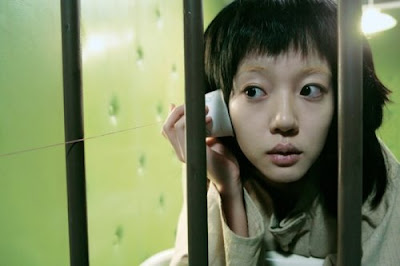
Actress Su-jeong Lim, one of the sisters in the haunting A Tale of Two Sisters, is again quite excellent in a unique and unprecedented role. Rain helps her to carry the film, and he may be hoping to go west with future films, already appearing in the new Speed Racer.
I think the gentle pace and humour of I’m A Cyborg will appeal to a new audience who enjoy 'World Cinema' and haven’t seen the director’s earlier ultra-violent black comedies. But for his fans, this must come as a big disappointment.

I watched the Hong Kong region 3 release. But this will be on DVD and Blu-Ray in the UK (from Tartan) by the end of May, under the simple title I’m A Cyborg. Non-English DVD releases are already out in France and Germany.
May 18, 2008
SORCERER (1977) - William Friedkin's WAGES OF FEAR

(1977, USA)
While watching Sorcerer for the first time in many years, I recalled first seeing it in a London cinema in 1978, when it was called Wages of Fear. It was on a double-bill with Phase IV – another surreal film that would also fox any marketing department looking for an easy sell. At the time, I made a note that I’d been “confused” by the film - granted that I was only a teenager at the time. But seeing the region 1 DVD was something of a revelation – because the US version is half an hour longer. The story finally makes sense. I now think it's easily one of Friedkin's best films, and Scheider’s best roles.
On its initial US release, under the mystical title Sorcerer, it made only a small fraction of its budget back, opening in the galactic wake of the first Star Wars. Audiences were more interested in seeing Star Wars over again, than seeing anything else – especially when the first 20 minutes was subtitled, and over two hours was downbeat.
The long globe-trotting prologue introduces four men from widely different backgrounds getting into so much deep trouble that each has has to run and hide deep in the South American jungle. A hitman, a terrorist in Jerusalem, a corrupt businessman in Paris, and a getaway driver in New Jersey in trouble with the mob.
I didn't remember any of this entire opening at all, only to learn it was lopped off from the European version I’d seen in 1978. That version starts in an unnamed South American village, with the four runaways hiding out in a hellish backwater so deep in the jungle, they can no longer afford to escape. Without their backstories, it was harder to work out who the central characters were and why they were stuck there. The only local employer is an oil company, but when an accident ignites the rig, no one can work, and the village descends into chaos, their only source of income cut off. The four exiles gradually team up for a mission that's very likely to be suicide.
The locations look like a trip into the unknown. The section of village where they get stranded was designed and fabricated as an extensive, shabby, outdoor set, unfairly portraying the (unnamed) Dominican Republic as a hopeless hellhole of a country where people lie in the streets, barely alive.
The story then clicks into gear as they are asked to drive 200 miles across roughly-hewn roads through the jungle, in lorries carrying extremely unstable dynamite, needed to extinguish the fire at the rig. To airlift this explosive is impossible and the political situation in the country means that outside help is out of the question. For a chance at big money, and an escape from their respective hells, they agree.
Without the use of miniature effects, the action is shot on location, even the gigantic explosion that ignites the oil rig. It all looks totally real. The huge lorries cross collapsing bridges, rocky canyons, and get stuck in the jungle. The iconic scene (on the album cover and poster campaign), shows the trucks swaying on a rope bridge in a tropical storm. Admittedly, the collapsing bridge is carefully constructed with steel cables, but looks like wood and rope. This didn’t prevent the production losing several trucks in the river! There's more background on the making of the film, here on Urban Cinefile.
The mission couldn't be more suspenseful. Any sudden jolt can set off the unstable dynamite. Every bump in the road puts the audience on edge. The cinematography captures the thick humid atmosphere, and the drivers’ stressful descent into a waking nightmare. The surreal landscapes they encounter are complemented by the bizarre synthesiser soundtrack by Tangerine Dream.
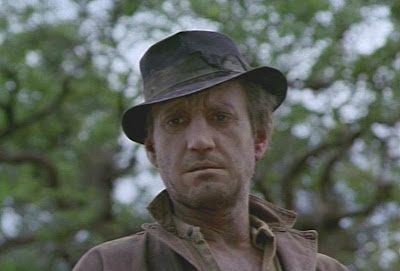
Roy Scheider conveys every mile of his ordeal, ending up looking like a walking ghost of his former self. Of course, I won’t spoil the ending, but the original climax only makes sense if the prologue is intact. I certainly don’t remember that ending, indicating that once the opening scenes had been removed, the European release ending was changed as well, making it far less impressive as an experience. Seeing the long version on DVD has altered my opinion of the film drastically, to one of bountiful praise!
The original French film was directed by Henri-Georges Clouzot (Les Diaboliques, Le Corbeau). but I only caught it on TV in the eighties, after seeing Friedkin's Wages of Fear in the cinema. I missed the jungle and the blood being in colour. The only scene that caught my imagination was one missing from Friedkin’s film, when the lorries have to drive fast to 'aquaplane' over a bumpy road.
In any case Sorcerer flopped, removed from US cinemas to make room for an extended run of smash hit Star Wars. Years later, even when the DVD was released, it was panned and scanned (from 1.85) to 1.33. When movies are hits, they get special editions. When they flop, they get dumped on the market. At least the DVD has the longer version, and I don’t think the cut-down version will appear again, as Friedkin is reported to have been far from happy about it.
 |
| Photoplay magazine (UK) May, 1978 |
UPDATE, October 2013
After a brief legal battle to discover which film studio currently held the rights to Sorcerer, William Friedkin oversaw a brand new transfer of his original cut fo the film, restored for cinema screenings (in 35mm) and for an upcoming special edition blu-ray release in 2014. It's been a long wait - but this is an adventure finally worth praising.
JOHN PHILLIP LAW - Pygar joins the angels
As I understand, the actor never stopped working, smiling and looking younger than his years, up until the end. He always brightened up the Hollywood movies he featured in, but it’s three of his ‘Italian’ starring roles that have kept playing, as cult favourites.
In both Barbarella and Danger: Diabolik (both released in 1968) he nailed the characterisations and appearances of two comic book characters so accurately, that he still personifies them. As Pygar the blind, winged ‘angel’ of Barbarella, he sensitively portrayed a blind and innocent prisoner of the Great Tyrant. His physical performance was magnified by appearing half-naked throughout the film. I was very aware that while there was plenty of male nudity in sixties cinema, not many actors were as attractive. I was so impressed with Pygar, that recently he’s even been my avatar in many movie forums. A choice that currently feels disrespectful.
Barbarella is one of my top three films ever, and I'm surprised it's not more widely popular than a cult status.
I was hoping that the planned Robert Rodriguez remake of Barbarella (currently cancelled) would have thrown Law back into the limelight. As it stands, I don’t even know if he’s been interviewed or recorded for any sort of Special Edition of Barbarella, which is long overdue on DVD. Paramount only have Jane Fonda, Anita Pallenberg and Milo O’Shea left around to interview from the main cast.
.jpg)
In his next film, as Diabolik, he swapped from Angel to Devil, as the greedy super-villain anti-hero, in a world where there was no super-spy or master detective who could touch him. His physical resemblance to the comic book villain is quite uncanny. Danger: Diabolik was a rare movie adaption of a comic strip where the fans are well-served by the result.
There are hardly any spaghetti westerns that I’ve enjoyed that didn’t have Clint Eastwood in them, but Death Rides A Horse is an exception. It’s a shame that Law didn’t garner the same opportunites as Eastwood when he returned to the US.
These films have proved entertaining for forty years so far, and will continue to preserve his memory for many years to come.
May 14, 2008
THE GIRL WHO LEAPT THROUGH TIME (2006) an anime hit?
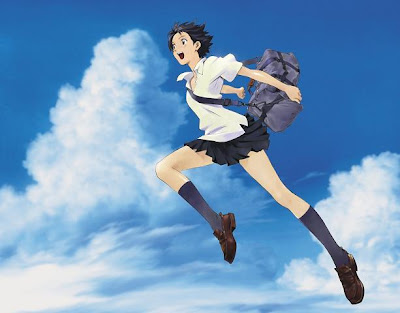
(2006, Japan, Toki wo kakeru shôjo)
This animated feature film from Japan is heading for a limited cinema release in the USA in June. It’s one of the few anime movies that isn’t directed by Hiyao Miyazaki to get the chance, though having seen it, I’m uncertain why it has been picked out.
Possibly because its visual look is quite similar to a Miyazaki. But this has been animated at Madhouse Studios, rather than Ghibli, and directed by Mamoru Hosoda. The almost photo-realistic look achieved with the colouring and ‘lighting’ of modern city scenes, shows a careful and beautiful artistic approach to traditional 2-D animation that’s been abandoned by the big western animation studios. It still uses 3-D animation as a way of portraying certain moves and special scenes, like the time-travel space she falls through, but essentially you won’t see flat animation this good outside of Japan.
Makato is a typical high school student who has a particularly bad day. Just before she has a serious accident, she jumps back in time to live through her unlucky day again, but making everything right. But in doing so she causes trouble for many others around her, especially her friends. As she attempts more time jumps to unravel the mess, the trickier her life gets. What she really wants is for everything to get back to normal, so she can play baseball with her best friends…
It’s a drama and a comedy, but I was expecting something a little more sci-fi, but this is more like Somewhere in Time or Sliding Doors, but without the snogging – mainstream Japanese romances usually avoid any physical contact whatsoever!
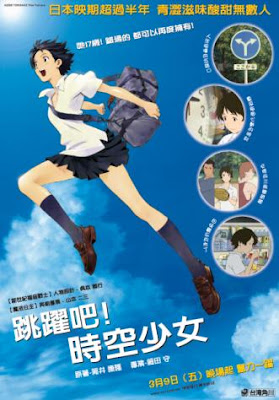
I was hoping to see something new done with the time-travel angle, but the timespace limbo she falls though was rather sparse and functional. The only impressive visual effects were some beautiful frozen-time tableaus. It’s well-directed and a story well told, but I was underwhelmed by the familiar time-travel paradoxes and the frustrating Dawson’s Creek neuroses of the main characters.
Where the recent, hugely popular Miyazaki films have usually been set in fantasy lands, The Girl Who Leapt Through Time is in present day in a high school (like so many anime series). I wondered exactly why the story was chosen for animation rather than live-action, as the many dialogue scenes begged for real actors, and could easily have been filmed in actual locations.
I wasn’t surprised to find that the characters, created by Yasutaka Tsutsui (who also wrote Paprika), had appeared in two live-action movies before – both called The Little Girl Who Conquered Time, filmed in 1983 and 1997. Perhaps these will get a re-release to follow on from the anime’s success.

The theatrical release in the US means that a DVD release will eventually happen, but you’ll have to wait a little longer. I watched the Hong Kong region 3 DVD from Kadokowa Video, which has anamorphic widescreen and good English subtitles. It’s also already out in France and Germany.
DVD Beaver has also looked at this disc and published some nice non-spoiler framegrabs.
- - - - - - -
GUNHED (1989) - Japanese robot wars
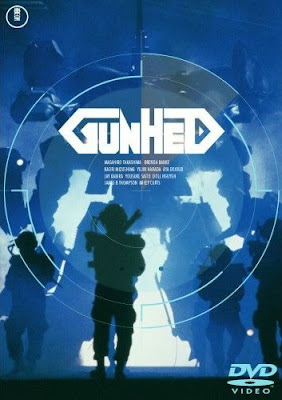
(1989, Japan, Ganheddo)
Uh-oh – it’s an Alan Smithee film…
Great miniatures, great visuals, great sets and a video game scenario that was well ahead of its time – why is Gunhed so frustrating to watch?
I was excited by a 1992 pop video for a track called Mindphaser by Frontline Assembly (or FLA), a Canadian heavy electro band. The visuals seemed to work perfectly with the music. The band members are seen in a futuristic cockpit driving a huge robot-tank, capable of changing configuration as it rolls along. The modelwork looked intricate, but there was live action and futuristic military costumes – surely this wasn’t all built for a pop promo?
The promo director had been given the Japanese film Ganheddo to cut down for the video clip. I looked out for the original film and it arrived in the UK on VHS soon after, as Gunhed. But the music wasn’t as good in the film, and the English dub of the film was terrible. I even sold my VHS thinking I never wanted to see it again. Now on DVD, I wanted to give it a second chance, in widescreen and in the original languages.

It begins well, with a quick recap of a future war between humans and machines, then a huge dropship approaches a vast fogbound island/city, entirely defended by robots who have successfully taken over the valuable refining complex. The action kicks in straight away, as a wireframe computer animation shows the extent of the island complex, reminding me of a similar story device in the far more recent Resident Evil movie.
The film looks good for its age – though the animated electrical effects date it. The modelwork would still look good in a modern Japanese sci-fi, and is often spectacular. The complex Gunhed miniature, with lots of missile launchers and robot arms hanging off it, sometimes wobbles a bit too much as it trundles along.
But it’s the humans that really let the film down. There’s initially some fun to be had with Brooklyn the bandit (Masahiro Takashima) and a female Texas Ranger (Brenda Bakke) developing a love/hate relationship. The script then makes the mistake of splitting them up for the rest of the story. Brooklyn is then left to talk to the humourless Gunhed computer, which isn’t nearly enough of a character, considering he has so much to say.
As Gunhed rolls into action, it displays some really neat tricks, with a barrage of grappling hooks, riding up walls and spouting a variety of missiles. But during it’s debut action scene, the complete lack of music makes it a far less exciting spectacle than it should have been. Again, the same scenes in the pop promo were far more effective because of better music. The camera is so tightly framed, it's hard to see what's going on. Gunhed gets out of some really tight corners unexplained, and the robot wrestling goes on for far too long.
The story and the action get more confusing as it progresses and towards the end the editing is almost shoddy, as if everyone had given up and wanted to go home.
The director of the US version has declined to keep his name on it, hence the generic replacement Alan Smithee name. It looked avoidable too - the film seems to have been sabotaged in the editing stage. It could have been salvaged, with some clarification from the onboard computer about what the hell is going on, tighter editing and more and better music.
Gunhed stands as a huge effects showreel for a missed opportunity. almost a glimpse of what an 'Aliens vs T2' scenario might have looked like. There is a substantial budget on show, especially with the huge cyber-sets and inventive design work. Good matte paintings add to the feeling of scale. If only as much effort had been lavished on the post-production.

A DVD has finally appeared in the US, from ADV, with an English-only option (with poor dubbing filling in what little Japanese dialogue there was) as well as an original language option with subtitles. The picture is non-anamorphic widescreen, and a couple of analogue video faults indicate that it's not been digitally remastered yet. It’s a rare chance to see it, if those posters still tantalise you.
A murky copy of the Frontline Assembly video is also on YouTube at the moment, pity it’s not on the DVD.
Gunhed is not without it's admirers, especially this guy on SFF World.
May 13, 2008
KRAKATOA - EAST OF JAVA (1969) - or is it west?
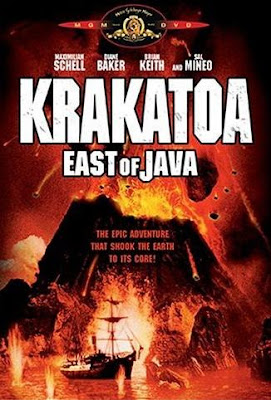
(1969, USA)
Nice visual effects, shame about the songs
After reading Eugene Lourie's book 'My Work In Films' (1985, Harvest/HBJ) and how his methods for recreating volcanic special effects for Crack In The World (1965) were later reused in Krakatoa - East of Java, I thought it was about time to see it in widescreen. It's also just been released on DVD in the UK.
Lourie worked as a production designer for Jean Renoir in France, then fled the Nazi invasion to live in the USA, where he also designed special effects and started to direct (The Beast from 20,000 Fathoms, Behemoth the Sea Monster, and of course Gorgo). He later returned to Europe, often favouring Spain for both studio and location filming – just as he did for Krakatoa – East of Java.
According to Lourie it was shot in 70mm, but the credits call it Cinerama (a process of filming with three cameras line up next to each other), which indicates that the film was destined for gigantic screens. Specifically for Cinerama theatres, (you could think of it as an IMAX for the fifties), extra long point-of-view shots are included to add to a rollercoaster feeling. On a huge screen, when the camera spins around, or tilts like a boat in the rough seas, the audience are going to get more than a movie but an experience, possibly of nausea.
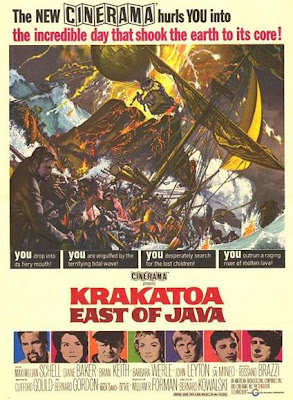
While the bulk of the action is a grim adventure, the Cinerama label demands something more of a family film, resulting in an unlikely triple volley of songs at the start! These are in addition to the three-way splitscreen musical montage of spoilers behind the opening titles, again trying to look like true three-camera Cinerama.
There’s then a bizarre schoolsong, coaxed along by two sweaty nuns, trying to distract a class of frightened children from a volcanic eruption. This mystifying scene doesn't gain significance for nearly two hours of screen time! After a dollop of dockside exposition, there's a rather modern ‘west coast’ pop ballad as the steamship 'Batavia Queen' sets sail. After more introductions to the key characters onboard, there's a third song, staged like a screen musical, as over-the-hill chorus girl Charley dances and ickily vamps her ageing boyfriend. Considering the duration, these songs feel like inappropriate padding, and a disastrous way to start a catastrophe.
Thankfully it settles down to a more even keel, with grittier dramatic conflict and the eerie signs that a huge eruption is imminent. Little do the crew realise, it'll be the hugest Earthly explosion in recorded history! But this is no documentary, more like a Jules Vernean adventure.
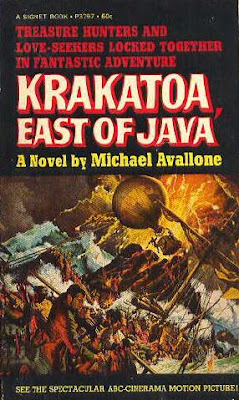
The Captain is more interested in a fortune in pearls and has recruited a diverse A-Team of experts. To scout for the wreck, there are two balloonists and a guy with a diving bell. To retrieve the booty, there’s a deep sea diver aided by Japanese pearl divers, with very impressive lungs.
The script pushes hard some unusually liberal sixties amoralising, considering it’s supposed to be 1883, with some strident messages about relationships outside of marriage, judgemental attitudes about murderers, forgiveness... All this and an opium drug dream montage too.
There's so much going on onboard, no wonder everyone isn’t bothered about the pumice mortars flying overhead, and the endless volcanic explosions. As they get closer to their goal, the story contrives to take the audience down inside the crater just as it’s warming up, right past the lava flows as it starts to erupt (in a marvellously hellish scene reminiscent of the climax of The Black Hole), and hangs around to experience both the final explosion and subsequent tsunami.
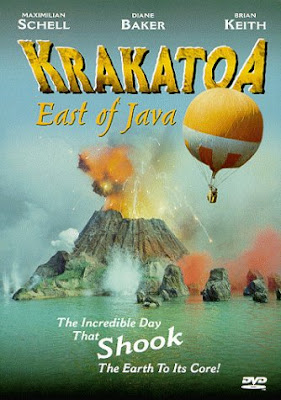
The visual effects range from silly to spectacular. The balloon looks like a small model, as does the master shot of Krakatoa (stupidly, this shot is on the cover of the Anchor Bay DVD). As the action moves closer in, the huge tenth-scale model of the steamship set against the exploding lava is a hugely complex setpiece, that makes for a convincing and exciting scene, the deck getting pummelled by flaming debris. Basically the special effects get more impressive as the film progresses.
Lourie’s special effects help carry the film, along with the solid cast. Maximilian Schell (who had command of a spaceship in The Black Hole) is convincing as the single-minded Captain, sparring with junkie diver Brian Keith (The Wind and the Lion, The Zoo Gang, Meteor) and a hold full of convicts, lead by J.D. Cannon (the angry Police Chief in McCloud). The father and son balloonists are played by Rossano Brazzi (The Italian Job, Omen III: The Final Conflict) and Sal Mineo (Rebel Without a Cause, Escape from the Planet of the Apes). Geoffrey Holder (Baron Samedi in Live and Let Die) appears imposingly, but doesn’t get a single line of dialogue. Also keep your eyes peeled if you want to see Eugene Lourie himself, in a brief appearance as a lighthouse keeper.
It’s a mad example of a catastrophe movie, the link between the old historical epics of the fifties and the disaster movies of the seventies. But even The Towering Inferno had a song in it…
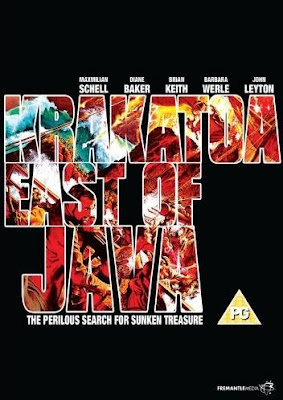
The Anchor Bay disc had a sharp picture and a generous anamorphic widescreen presentation (with a full-frame option on the flipside). Since then, it's been re-released on DVD by MGM in the US, and last month by Fremantle in the UK.
- - - - - - -

